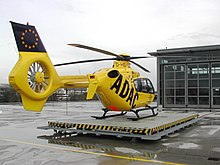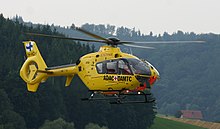Christoph Europe
Christoph Europa was introduced as a radio nickname for rescue helicopters (RTH) at locations close to the border, to make it clear in the name that the area of operation of air rescue is not limited to one state and that the helicopter can also help neighbors across the border in the event of an alarm comes. With the nickname from Europe and a number, this is a slight deviation from the usual designation in Germany, which is usually just Christoph X. X can either be just a number (e.g. Christoph 1 in Munich) or, in the case of intensive-care transport helicopters, only a local geographical name (e.g. Christoph Westfalen ).
This identifier was first used on March 1, 1998. At that time, ADAC Luftrettung took over the helicopter station at the Aachen-Merzbrück airfield in Broichweiden ( Aachen city region , North Rhine-Westphalia ) from the Bundeswehr. The RTH of the Bundeswehr had the military designation SAR 72. In order to make the international claim of the helicopter clear, the ADAC named the machine not Christoph 21, but Christoph Europa 1.
Since then, several RTH operators at home and abroad have followed this naming scheme; there are currently five “European rescue helicopters”. The designation Europe is arbitrary, however, since all rescue helicopters stationed near the borders with Austria, Switzerland or the Benelux countries regularly take on missions in the neighboring country. This also applies, with clear restrictions, to France, where there are still problems with the various rescue service systems and the assumption of costs. Cooperation with Poland and the Czech Republic has not yet progressed that far.
Christoph Europe 1
Christoph Europa 1 is a since March 1998 by the ADAC air rescue powered rescue helicopter , was previously since August 1974, a Bell UH-1 D ( SAR 72) of the Bundeswehr in use. The helicopter of the type EC 135 P2 is on the airfield Merzbrück stationed and is determined by the control center Aachen region (up to 2009 circuit Aachen ) in Aachen alerted. There the new control center for the entire district and for the city was built.
The rescue helicopter flies cross-border missions, like its predecessor SAR 72 in individual cases. Its area of application extends from the Aachen area to the neighboring countries of Belgium and the Netherlands . In 2015, 2162 rescue flights were completed, making Christoph Europa 1 the second highest number of missions of all German rescue helicopters (after Christoph 31 , Berlin).
Christoph Europe 2
The Bundeswehr operated an air rescue center in Rheine from 1982 to 1998 . A SAR helicopter of the type Bell UH-1 D with the military identification SAR 76 was used. In 1998 the ADAC air rescue took over the station. A Bölkow Bo 105 was used for a short time before the change to EC 135 took place. Today an EC 135 flies there in the performance variant EC 135 P2 . Because of its proximity to the Dutch border, the ADAC uses the nickname Christoph Europa 2 .
Its primary area of operation extends around 70 km around the base. It is possible to reach the neighboring Netherlands within a few minutes . From there, however, Christoph Europa 2 is only requested about 50 times a year. The helicopter is also used for secondary purposes, such as moving patients. The total number of missions is around 1200 per year. Since June 2003, Christoph Europa 2 has started from a new rescue station, which has been adapted to the requirements of today.
Christophorus Europa 3
The Christophorus Europa 3 has been stationed at Schärding-Suben airfield in Upper Austria, right on the border with Bavaria, since July 2002 , and has an operational radius of approx. 50 km. It is the first rescue helicopter to be operated jointly by organizations from different countries. The Christophorus Flugrettungsverein ( ÖAMTC ) is involved on the Austrian side and the ADAC on the German side . Mainly the clinics and hospitals Passau , Schärding , Ried , Deggendorf , Braunau , Linz and Salzburg are served.
The helicopter is replaced every six months. An EC 135 from the ÖAMTC is used there in the summer months and an EC 135 from the ADAC air rescue service in winter. This happens because the ÖAMTC needs its helicopters for additional seasonal locations in the ski areas in winter.
The rescue team consists of Bavarians and Austrians in equal parts , although the duty roster is not adapted to the seasonal change in aircraft. It is therefore quite possible that an emergency doctor from Austria, a Bavarian paramedic and a pilot from Bavaria will start working together on an ADAC helicopter in Suben, Austria .
Lifeliner Europe 4
In October 2003 ADAC-Luftrettung took over the air rescue center in Groningen, the Netherlands, from the private operator Schreiner Air. The pilots came from Medical Air Assistance , the air rescue subsidiary of the Dutch automobile club ANWB and UMCG , which also operates the other three Dutch RTH locations (Amsterdam, Rotterdam, Nijmegen). In order to underline the European claim, the RTH has had a European ID since then - but the name Lifeliner , which is common in the Netherlands, is continued. On December 31, 2019, the ADAC withdrew and handed the station over to the ANWB.
Christoph Europe 5
In the course of the restructuring of the air rescue in Schleswig-Holstein , the RTH / ITH Christoph 52 had to move to Niebüll in April 2005 . This helicopter of the German Air Rescue Service (DRF) was previously stationed in Hartenholm north of Hamburg or Hohenlockstedt near Itzehoe and had taken on both primary and secondary missions there.
The reason for the move was the high density of RTH locations in the Hamburg area (2 in Hamburg, more in Eutin and Rendsburg), while no rescue helicopter was available in the immediate vicinity for the north of Schleswig-Holstein, especially for the North Frisian Islands. They also wanted to try out cooperation with Denmark. There is currently no air rescue system that can be compared to the German one. On behalf of the Danish rescue service Falck and the responsible authorities, the DRF is also to take over operations in South Jutland , hence the European nickname for this H145 helicopter .
With the commissioning of the DRF rescue helicopter at the Niebüll Hospital, the starting shot was given for the first cross-border air rescue between Germany and Denmark. This is a pilot project by the DRF, the Danish rescue service operator Falck, the German district of North Friesland and the Danish administrative district Sønderjyllands Amt . The cooperation partners receive EU project funding according to Interreg III A, a joint initiative of the European Union to promote cooperation between cross-border regions.
In the first few months, however, only around twelve percent of the missions were in Denmark. There is no longer a 24-hour operation in Niebüll.
Until 2005 the rescue helicopter locations were in Schleswig-Holstein Itzehoe (24 hours), Rendsburg (24 hours) and Eutin. Since 2005, the rescue helicopter locations in Schleswig-Holstein have been Niebüll, Rendsburg (24 hours) and Siblin (near Eutin).
Cross-border air rescue without Europe identification
Rega fleet
The Swiss rescue helicopter Rega 2 from Basel flies more than half of its missions in southern Baden. Rega 1 ( Zurich ) and Rega 7 ( St. Gallen ) also frequently fly to Germany.
Christoph fleet
On October 1, 2003, the German-Dutch cooperation between the border regions around Kleve and Limburg / NL started with the support of EU funds from the Euregio in the field of air rescue: Christoph 9 from Duisburg also flies to the Netherlands if necessary, Lifeliner 3 from Nijmegen ( Netherlands) takes on assignments in Germany. Christoph 16 from Saarbrücken also takes on assignments in neighboring France if and when required.
Christoph 14 from Traunstein , Christoph 17 from Kempten (Allgäu) and Christoph Munich, who is equipped for night missions, also take on missions in the Bavarian-Austrian border area.
Others
The Luxembourg Air Rescue flies from its Luxembourg airport, especially operations in Rhineland-Palatinate and the Saarland . Air Rescue 1 is stationed at the duty hospital in Luxembourg City, Air Rescue 2 in Ettelbrück and Air Rescue 3 at Findel Airport. You can be alerted directly by the control centers in Trier and Saarbrücken .
In Tyrol , several RTH private operators are stationed directly on the German border: Heli 3 in Kufstein, RK 2 in Reutte.
See also
literature
- ADAC Luftrettung GmbH: ADAC station atlas "Christoph - please come!" Munich 2006, ISBN 3-933266-46-7 .
Web links
- Website of Christoph Europa 1
- Website of Christoph Europa 2
- Christopherus Europa website 3
- Christoph Europa 5 on the DRF website
- Christoph Europa 1 , Christoph Europa 2 , Christophorus Europa 3 , Lifeliner Europa 4 and Christoph Europa 5 on rth.info on rth.info
Individual evidence
- ↑ Operation figures of the air rescue . rth.info, accessed July 31, 2016.
- ↑ Luxembourg Air Rescue ( Memento of the original dated September 30, 2015 in the Internet Archive ) Info: The archive link was inserted automatically and has not yet been checked. Please check the original and archive link according to the instructions and then remove this notice.






